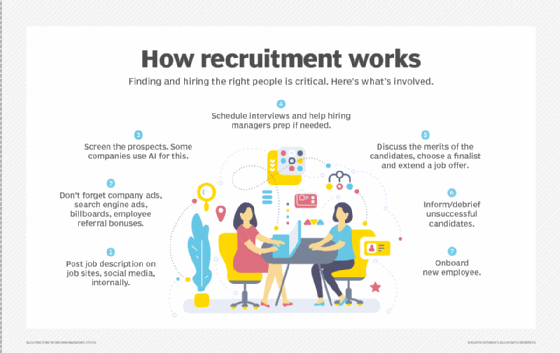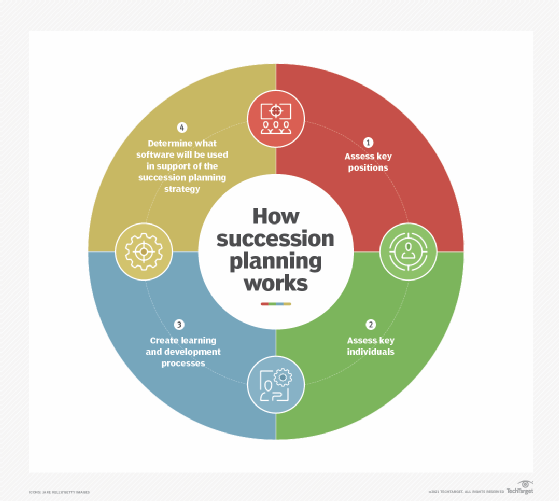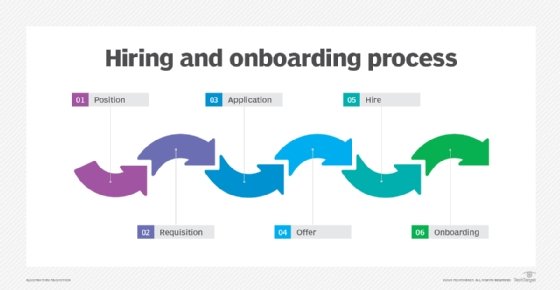10 top talent management software systems in 2025
Learn about some of the best talent management products, the advantages and disadvantages of each system, along with important considerations for implementing the software.
The right talent management software can streamline tasks and save time. But as the talent management software market grows, buying teams need to get savvier about which products should make their shortlist. They also need to understand some of the pros and cons of the leading vendors and systems before buying a new one or replacing their legacy software.
Before getting into specifics on the product choices, it's important to have a clear idea of what talent management is and how it gets automated in software.
What is talent management?
Talent management spans an employee's entire lifecycle at a company and includes all the processes, guidelines, tools and systems needed to attract, retain, develop, engage and manage employees. It's typically carried out by the HR department with support from managers.
Talent management is intended to meet the human capital needs of the enterprise by hiring people with the right skill sets, training them, evaluating their performance and compensating them appropriately.
This article is part of
Ultimate guide to recruitment and talent acquisition
What is talent management software?
The need to attract, reward and engage employees is critical -- but it isn't easy. Talent management software can help automate those processes.
Talent management software refers to the systems and applications that digitize the major stages and business processes of the employee lifecycle.
Many companies use several HR systems for talent management. For example, they might use a core HR system to track basic employee data, another system for performance management and a third for learning management. However, there are software suites that provide most of the talent management functions in one system with a consistent look and feel. Talent management software often includes self-service options for employees and managers that enable them to make certain changes and add information without HR's assistance.
Key talent management software features
Talent management software features are usually categorized by modules, each of which handles a specific function. For example, a compensation module helps manage pay-related functions like raises and bonuses.
Another key software feature, AI, has rapidly grown in importance. Vendors are introducing new AI features that can simplify and automate some of the most important tasks. The initial push for AI was for use in recruiting, but it's gaining momentum in many other areas of talent management as well, such as succession planning.
Here's an overview of each talent management system module. Standard functions are often similar across vendors.
Core HR, the administrative foundation of talent management, stores information about every employee in one database and provides comprehensive reports on the data. It also typically provides the employee and manager self-service options. Some vendors include benefit administration in core HR.
Employee engagement provides employee surveys and tools for comparing employee satisfaction to that of peer organizations. It also includes mechanisms for employees to recognize each other's achievements and receive awards.
Recruiting includes a portal for candidates to apply for open positions and integrates with popular job boards and the core HR module. It also helps identify candidates already in the database who match new job postings.

Onboarding enables new hires to complete employment forms and digitally sign documents. It also gives new hires access to onboarding before and after their start date and enables HR staff to share additional information about the company with new hires, such as org charts and welcome videos.
Performance management enables users to apply performance data to other functions, such as compensation management and succession planning, and provides employees and managers a variety of options for discussing performance and career plans. It also supports customized employee feedback.
Compensation helps managers determine salary increases, bonuses, stock options and grants. It provides performance data for determining compensation and helps managers consider external data, such as salary rates, when deciding on salary increases.
Reporting and analytics combines data from different modules into one report if the system is all-in-one. It also provides the ability to create custom dashboards or use default dashboards, as well as configure reports and dashboards to automatically send to certain users.
Learning and development enables users to establish a course curriculum, add content such as articles and videos and incorporate content from third-party vendors.
Succession planning helps identify employees who have the skills and competencies for other positions, in part by incorporating performance-related data, and provides employees with career-planning tools.
Document management facilitates the sharing of corporate documents with employees and controls permissions for certain documents.

Advice for buying teams
The most critical aspect of a vendor evaluation is identifying the features that make the product stand out from its competitors and deciding whether the product meets the organization's requirements. Buying teams should also consider implementation and licensing costs.
When evaluating an all-in-one talent management package, the buying team should consider whether the platform enables users to work with data across different modules. For example, skills data might be valuable in various situations, such as rating employees in performance management, looking for internal candidates to fill open positions and auto-assigning development training to employees.
When evaluating vendors that are more specialized, the buying team should consider integration capabilities, since users will likely find it valuable to exchange data between systems. For example, users might like the ability to push performance management data to the compensation planning tool, then transfer employee compensation changes to the company's core HR module.
10 of the top talent management software systems
A plethora of talent management software products are available and can benefit companies in various ways. These 10, shown alphabetically, are among the top software products based on sources such as G2, Capterra, Gartner, Forbes and vendor websites as well as the author's personal experience. The list includes both all-in-one talent management suites and standalone applications that focus on one aspect of talent management, such as compensation planning.
360Learning
360Learning is a collaborative learning platform that employees can use to share their expertise with others. Features include a learning management system (LMS) and learning experience platform (LXP), as well as the ability to create communities and AI tools that help employees find the content most relevant to them.
Pros
- The platform combines an LMS and LXP in one system.
- The software integrates with many other tools to provide learning opportunities in the systems employees already use on a daily basis, such as sales software.
- 360Learning enables any user to create content and share knowledge.
- It also includes controls for employee sharing.
- It integrates AI capabilities, such as recommending training for employees, into the system.
Cons
- Reporting and dashboards could be improved.
- The number of features and configuration options can make it difficult for new users to learn the system.
- Co-creating courses can be difficult at times, especially when two people are trying to edit concurrently.
BambooHR
Developed for SMBs, BambooHR offers many features to support the employee lifecycle and a UI that's intuitive for employees and the HR team. The system is easy to integrate with niche products that have prebuilt BambooHR interfaces.
Pros
- The platform is affordable for many companies.
- The system centralizes, tracks and analyzes data.
- Integration and maintenance are easy to carry out.
- Tech support responds quickly.
- The UI is easy for employees to use and understand.
- The vendor doesn't require a contract, and customers can cancel any time before the next payment.
Cons
- Default reports are not always configurable and do not always contain key data such as employee ID, first name and last name.
- Configuration options are not always granular enough when setting up security roles.
- Configuration settings, such as hiding an employee's birth year from certain users, are limited.
Ceridian Dayforce HCM
Dayforce was designed for global companies that want payroll included in their HR systems. The system also includes the most common HR modules, including recruitment and core HR.
Pros
- The platform enables users to manage a global workforce, with features to support different currencies and country policies.
- Dayforce Wallet enables employees to receive their paycheck at a time of their choosing -- as long as it meets company guidelines.
- The process for resetting the test environment is simple and efficient.
- Users can manage all HR tasks in one system, with modules including core HR, learning, time and attendance, and career planning.
Cons
- The system uses position management, which can add a layer of administration for companies that don't require this feature.
- Ceridian can sometimes take a long time to implement feature requests.
- The UI is acceptable but not very modern.
- Managing the system is fairly complex, and system administrators might find it especially difficult if they're only performing the role part-time.
ClearCompany
ClearCompany's software can help companies with recruiting, onboarding, employee engagement and performance management. The system also includes a reporting and analytics tool so HR staff and company leaders can track the progress of their respective processes.

Pros
- The applicant tracking system (ATS) has AI tools for many processes, such as scoring resumes and drafting job descriptions.
- The performance management module has an integrated library of competencies.
- The software offers prebuilt interfaces for common systems, such as email, calendars and HR systems.
- The UI is modern and intuitive.
Cons
- Reporting and dashboards are not very intuitive or customizable.
- Employee recognition tools do not track points for employee rewards.
- Companies will still need to use a human resource information system (HRIS) to manage core HR data.
HRSoft
HRSoft's software enables users to automate performance management, compensation, pay equity and total reward statements. The overall focus of the software is compensation -- including making it easier to allocate pay increases and examine pay equity -- and employee total rewards.
Pros
- Users can refer to performance feedback when carrying out compensation planning.
- The platform supports multiple currencies.
- HRSoft also supports complex compensation plans, such as plans by country, one-time increases, and stock, options and bonuses.
- Employees can view their compensation data in total rewards statements.
Cons
- HRSoft is slightly more expensive than some of its competitors.
- Companies must pay for some of the product training for administrators.
- Interfaces between HRSoft and HRIS vendors aren't always seamless.
Kudos
Kudos is employee reward and recognition software. It also includes employee surveys and features for sharing photos and information. Companies can integrate the system with many common applications.
Pros
- The software enables employees from multiple countries to redeem their points.
- Users can give awards to employees based on internal goals that match the corporate culture.
- The system supports nomination-based recognition, such as employee-of-the-month programs.
- The UI is easy to learn.
Cons
- Users might find it difficult to determine who is the subject of feedback for employee recognition.
- Managers cannot easily access Kudos' employee recognition data when creating a performance review without navigating to the Kudos platform.
- The software is focused on rewarding past behavior and doesn't give users a way to incentivize employees to earn a reward, such as creating a team goal that would give participants a certain number of points when achieved.
Lattice
Lattice's software includes performance management, compensation, development and employee engagement. The vendor is also in the process of developing an HRIS that will integrate each module's data, eliminating the need for a third-party HRIS.
Pros
- The engagement functionality includes many useful tools, such as the ability to survey new hires, calculate employee Net Promoter Scores and send out pulse surveys.
- Users can view performance management data when carrying out compensation planning.
- The software integrates with popular messaging tools, which can make public recognition easier to carry out.
- The Grow module helps HR, managers and employees set development goals and manage ongoing employee and manager feedback.
Cons
- The numerous performance-review options available to employees and managers can make the process more complicated.
- The UI is not always intuitive, especially for new users.
- Custom reports can be difficult to create.
- Naming conventions might not meet a company's needs and sometimes can't be edited.
Salary.com
Salary.com's software focuses on total compensation, including salary surveys and associated data, pay equity features, job description management and tools for determining the pay for particular jobs. Salary.com acquired the compensation planning company CompXL to further round out its offering.
Pros
- The platform includes a wide range of job types for users to review when pricing jobs.
- The software comes with prebuilt integrations to major HRIS platforms.
- It has tools to help manage pay equity as well as diversity, equity and inclusion efforts.
- The job description feature enables users to collaborate with other employees when developing or updating job descriptions.
Cons
- Users might find it difficult to push job descriptions written in the Salary.com software to the organization's ATS.
- The database might not include all the job types needed for compensation comparisons or compensation data for certain regions.
- Users may find it difficult to learn the software because it includes many features and options.
SAP SuccessFactors HXM
SAP SuccessFactors HXM is a suite that offers all the functionality needed for talent management under the umbrella of human experience management (HXM). The software is targeted at large organizations. It's configurable and has a consistent look and feel across the platform.
Pros
- The performance management and compensation modules are well-integrated.
- The system is all-in-one and includes advanced reporting and dashboards.
- The platform supports many currencies and languages.
Cons
- The software was built by acquiring several applications and includes multiple databases.
- Administering the suite can be cumbersome because acquired modules require their own configuration. For example, users will need to set up security roles in different places depending on the applicable modules.
- The platform is complicated to maintain, from an administrative perspective.
Workday HCM
Like SAP, Workday is one of the biggest vendors in the HR software market. Workday offers a comprehensive and configurable SaaS talent management system for U.S. and international users.
Pros
- Complementary modules are available for finance, planning and analytics.
- The UI is intuitive for employees.
- The system's integrated platform enables HR system administrators to manage the entire system from one place.
- Workday supports multinational and large organizations with complex needs.
Cons
- Implementing a large system like Workday takes more time than midmarket software.
- The process of customizing and implementing new features can be expensive.
- The system can be rigid, requiring the system administrator to approve and configure many changes, such as adding a question to a list of candidate interview questions.
- Tasks such as submitting time-off requests or tracking hours worked can be complicated to carry out.
Although no system will fully remove the complexity of talent management, taking the right approach to choosing software can help HR create a positive candidate and employee experience.
Editor's note: This article was updated in January 2025.
Eric St-Jean is an independent consultant with a particular focus on HR technology, project management and Microsoft Excel training and automation. He writes about numerous business and technology areas.






